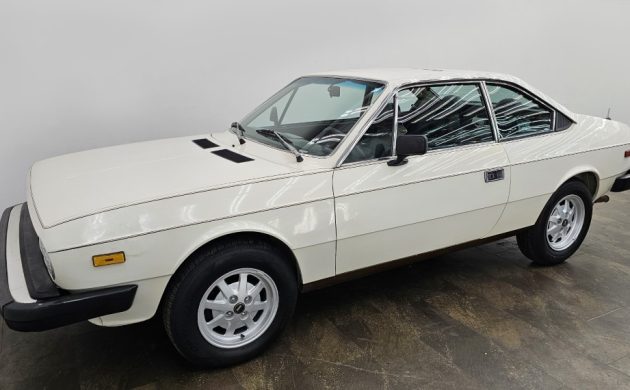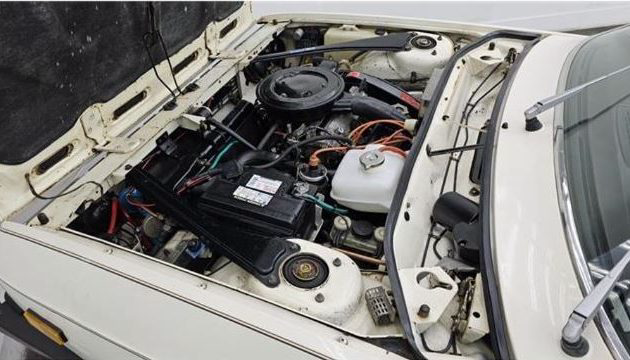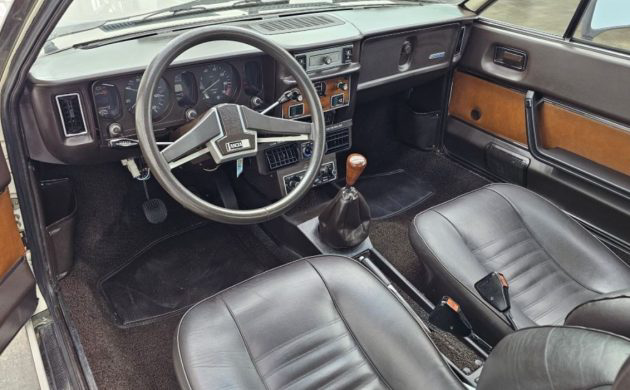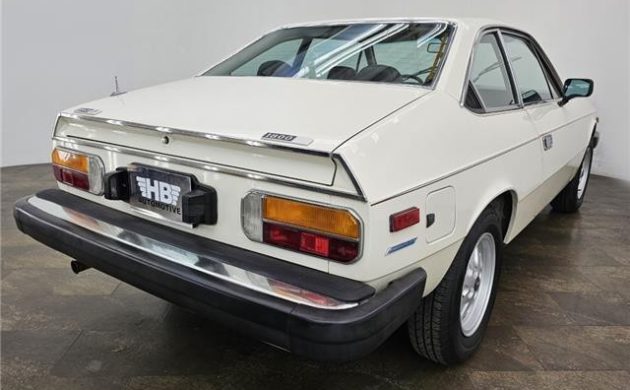UPDATE – This 1978 Lancia Beta coupé has arrived on the scene again, looking for a new owner just about a year after it was last sold. We featured it in January of 2024. The current owner has listed it here on eBay, cleverly disguised as a Mercedes-Benz in the advertisement, with bidding now sitting at $5000 – a far cry from the last sale which was at least twice the price, not including shipping costs. As is too often the case, the current owner found that the car was not perfectly represented the first time around. The window motors don’t work correctly, though new units come with the car; the dash lights indicating the brakes are engaged remain on whether braking or not; and the AC components are missing. The carb has been rebuilt and the wiper motor is new. The car runs and drives well though the seller suggests a carb adjustment. The car is now located in Springfield, Missouri.
FROM 1/26/24 – As Lancia was ruining itself financially while producing fabulous cars, Fiat waited in the wings, rescue-ready. The marriage was consummated in 1969 and after considerable duress, Lancia’s first model under its new owner rolled off the line: the Beta. Development was stymied by a lack of funds and an exodus of engineering talent. To reduce manufacturing costs, Fiat engaged in parts-bin construction and a swap with a Soviet steel company: we give you Fiat 124s to rebadge as Ladas, and you give us steel. The steel swap proved unwise. The steel was so thin, and rustproofing techniques so medieval, that Betas effectively disintegrated, especially in the damp UK which was unfortunately Lancia’s largest export market. On the heels of this costly problem, the Montecarlo cropped up with a brake issue that took two years to fix (and involved simply removing the booster). That said, surviving Betas offer a quirky but worthwhile solution to: I wanna take something different to Cars ‘N Coffee this year. Here on eBay is perhaps one of the finer examples available, this 1978 Lancia Beta 1800 coupé, bid to $11,212, reserve not met. The car is located in Sarasota, Florida.
Unlike most Fiats but in keeping with Lancia’s traditions, the Beta was architected as a front-wheel drive car. Fiat contributed its dual-overhead-cam, inline four-cylinder in varying displacements; Lancia reworked these to fit transversely. The engine and the five-speed gearbox are front-mounted on a subframe – a favorite place for rot to take up residence. This car has a 1756 cc motor, good for about 118 bhp. The odometer indicates 72,274 miles; the car has been owned by one Italian family since new. A move back to the home country prompts this sale. The car is said to start, run, shift, and drive very well.
Lancia excelled at providing its buyers with luxury: leather seating with contrasting door panels, wood dash accents, air conditioning. This car has a sunroof, and while we’re up there, the headliner is in great shape. The same can’t be said for the sun visors, as they have that “I’ve been baked so I bloated” appearance. The seats, gauges, and windows are said to work as they should, and the AC even blows. Well, maybe not cold, but “blowing” is a start. Accompanying the car are service records, a tool kit, and the original jack.
Reviewers of the day generally loved the driveability of the Beta; some variants successfully rallied. Meanwhile, though more than 435k examples were made, a Beta of any ilk is a rare find today. This survivor is in exceptional condition, but even so, I’m thinking the price is nearing its theoretical top. This nice example sold for just $14,600 recently. What do you think it will take to find this one a new garage?






There were still a few of these on the road when I was a teenager, and I always thought they were handsome. The price doesn’t seem out of line for a rare Italian sports coupe in this shape, but it could also be an expensive ticket to heartache…if you want one of these, though, they don’t get a lot nicer.
I’m with you. They are beautifully designed cars esthetically, but I’d really worry about how much tim I’d spend driving it vs working on it.
This one looks good in white, and I usually don’t like white cars. I think the HP quote is for a rest of the world car. US versions were quoted at 108 HP.
I remember seeing a few of this generation of Lancias around in the early eighties. They had an interesting range of body styles, this coupe, the Zagato with the targa top, a kind of bulbous sedan, and the neat little HPE estate. There were one or two of each sold in my small college town except maybe the sedan, or maybe I just don’t remember the sedan. The interior on the coupe looks nice.
North American market Betas did get detuned engines for emissions compliance, but 108 HP was for the ’81-82 fuel-injected 2-liter engines here; before that, they only had about 87 HP for both the ’75-78 1800 and the ’79 2-liter carbureted engines, tho’ the latter had about 15% more torque.
Few sedans were sold here, and that body style was pretty forgettable, the only Beta variant designed at Fiat Centro Stile to save time while Lancia designers worked on the coupe and HPE.
Pininfarina designed the spider variant from the B-pillars back, but conversion of coupe bodyshells into spiders was contracted out to Zagato, hence the US model name for that variant, IMO likely in part changed to avoid confusion with Fiat and/or Alfa spiders that were often sold at the same dealerships.
I am curious about the “thin steel” comment. The steel has a thickness specified by the Engineering group. The steel is purchased with the expectation it will meet the thickness noted on the purchase order and agreed to by the steel supplier. The steel is inspected for dimensional adherence before it is introduced into the production stream. How does ‘thin steel” get by so many inspection points?
I think they might have specified a thinner steel than other makes might have. I know with other Italian cars they would do that to save weight. With Alfa Romeo they had an issue with the quality of the steel purchased in the 70’s. That steel was more susceptible to corrosion. In addition they stored the car bodies exposed to the elements before a primer was applied so rust already had a foothold when the car was new.
I asked a Swiss metal broker about this once. It is not often you get the chance.
Lets recall, that all cars rusted badly everywhere and all the time, US, Japanese, UK, French, German . All cars.
His answer was complex. Steel in these quantities is bought in advance. In the mid 60s, Japanese car industry was looking to ramp up its production by going big time into US market. For other OEMs, how this affected your supply chain was the volume of your need and quickness of response. Italy was late to the party and forced to take lower quality steel. Usually described as Russian steel, Fiat could access the supply via tjeir LADA deal apparently. Poor transport and storage management also reduced quality.
But Michelle is correct, the specific problem which applied to the BETA, (corrosion regularly dropping its front subframe on the floor within 36 months) was a design fault.
Much to like about these cars if in excellent condition. Nice Bertone lines and excellent Fiat Lampredi drivetrain.
AFAIK the story that Russian steel was especially rust-prone or poorer quality has never been established with any credible documentation, so that “common wisdom” remains as dubious lore at best. More credibly, as you say, bodies were poorly rustproofed and often left unpainted for too long, in no small part due to frequent production disruptions and delays from labor unrest rife in Italy at the time.
The specific subframe rust-out issue only affected the very earliest run of Beta sedans, where the subframe rear mounting points had a design flaw that trapped water, often leading those mounts to rust apart after their first winter in heavily salted UK roads. This flaw was fixed by the time the coupe and other variants entered production.
This story about the “thin” or bad steel is hotly debated by Lancistis. The supposed proof of this has been thrown about uncounted times but the actual basis for it seems to elude research. It didn’t help that Jeremy Clarkson quoted it as truth without any real basis either.
Cars in the 70s rusted, no matter where they were made. Rust proofing wasn’t an exact science and in efforts to reduce weight, thinner steel was one approach.
No matter, the Lancia Beta remains one of the best handling FWD cars ever made. The rear suspension was a breakthrough that they should have patented.
I absolutely loved my 81 Coupe and would still have it except for a move to a climate it didn’t enjoy. But this is an absurd price.
I like the Beta models however the best of Lancia happened in the 60’s before Fiat took the reins. These cars were known for their long travel suspension. Really nice drivers. I would certainly entertain ownership and then promptly look for the euro bumpers.
Unfortunately, that “best of Lancia” era up through the ’60s is what nearly put them out of business, such that the marque’s survival depended on getting bought out. To paraphrase a line in one of Jamie Kitman’s columns, Lancia may be the only car maker to nearly go out of business, twice, by paying too much attention to quality.
Luckily, the Agnelli family who owned Fiat had a fondness for Lancia and orchestrated gov’t approval of their buyout for a token 1 Lira per share in 1969. Say what you will about Fiat’s creeping influence over Lancia from the ’70s-onward, we have Fiat to thank for the fact of Lancia’s continued existence at all.
These comments about steel are completely new to me. I had three of these in Australia (purchased new) and while some areas of them were a little dubious that didn’t extend to the body work. The panels were certainly not thin and the fit and finish was excellent – on mine at least. I’m not aware that they particularly prone to rust but admittedly cars generally don’t rust here anyway so who knows?
The “Russian Steel” thing is repeated all over the net, and it is absolutely never offered with any evidence at all.
The major problem with Italian cars rusting seems to have been leaving the bodies, unpainted, outside (Pantera, Alfasud, Fiat X-19).
I’m pretty certain that Italian labor unions would have had something to say.
I can’t say it isn’t true, but I have never seen anyone offer any evidence at all, and I I can remember a “Road & Track” article in the seventies on the new Maserati Indy noting rust on a new car and blythely stating, “Nobody ever bougth an Italian car for its rustproofing.”
My ’78 Beta had no issues at all, although I am aware of litigation in the UK about rusting subframes in early Beta Sedans.
I suspect it is an urban legend…….but if someone shows receipts, I’ll be convinced.
Sharp looking car. Add some big Hella lamps upfront, rugged tires..Rally time 🏁
Is it hard to change the timing belt?
Non interference motor?
The 1800 engine is an interference design, so if the timing belt age and mileage are unknown, the new owner would do well to replace it forthwith. The belt should be replaced every 30-35k miles and at least inspected for condition every 3 years regardless of mileage.
It’s not a difficult job, just a bit fiddly and with tight spaces to work in, the way everything’s Tetris’d in there underhood. I’ve done it a few times on my Beta Zagato spiders and wrote up the procedure as an article on the Lancisti forum.
My 1977 Beta Berlina manual stated that the timing belt should be changed every 17,500 miles.
JGD, I’ve got owner’s manuals for my ’82 and ’79 Beta Zagatos. The ’79 says the timing belt should be merely checked for wear every 30,000 miles and replaced if required. The ’82 says every 50,000 miles. Both say the belt should always be replaced if removed.
Evidently in the intervening years, belt manufacturing technology improved considerably, and/or they gathered enough longevity data, to be confident about extending the belt change interval. Current-day belts may well last even longer, but 30-35k seems a safe, conservative interval for a car that isn’t driven regularly.
I worked in a Fiat repair shop in Southern California in the mid 1980’s, and timing belt replacements were our money makers. We could do the job in much less time than the flat rate book allowed for. So, not a hard job. We also had Lancias and a few Alfas come through. I would imagine with the transverse mounted engine the timing belt replacement would be a bit more difficult, but should still be an easy job.
Cool little cars, had a couple of them years ago. This is OVER the top money for A Beta. Maybe if it was a Zagato or a Scorpion.
I have always liked these
I never owned one of these, but I always liked them and wanted one. They used to rust so badly. This one looks great and it was certainly well cared for. I think you might have a hard time finding a better example.
The first item of business would be swapping the front and rear “overbite” federal bumpers with Euro spec units. This will be a major visual enhancement to an already attractive design with an added benefit of few pounds shaved off the weight.
I’m glad it’s not the HPE wagon or I’d need to find space in the warehouse. I had 2 of them back in the day and thoroughly enjoyed them. Magically unique and so much fun to drive. I like the coupe also, but I’m a wagon guy and the sport wagon HPE is my weakness. I can’t remember how long it’s been since I saw any Beta this nice. I hope it finds a good home because it certainly deserves someone that will carry forth the proper stewardry it has obviously had. Beautiful car.
I owned on these in the mid 1980’s. It was a fun little car although it understeer a lot. It was a shame it was designed as a front drive. Unfortunately the engine caught fire while I was driving it due to one of the high pressure injector lines leaking fuel where it shouldn’t go. The car burned from the windshield forward and was totalled.
While the Beta does understeer, it comes on in the form of a gradual and neutral 4-wheel drift wide of the line as you exceed the limits of tire grip, rather than any nose-heavy plowing like you’d get in many other FWD cars.
This actually makes for great fun as the drift is very even, predictable and controllable, so you can go in hot and take a line slightly tighter than required, ride the drift out to where you want it, ease off the gas or tap the brakes to scrub speed and lock it down, then stomp the gas again to power out and away. “As if on rails” never meant so much until I got mine.
I have a Lancia Zagato 82 one of the last ones made ,its in RED .Its nice to see the prices of these going up ,they drive great . When i bought it i dropped the subframe & engine , rebuilt the engine because the previous owner let it run low on oil, checked out the subframe & repainted it with a under coating.
The body etc. is in great condition i have never thought of selling it ,but for 15k I might consider it, LOL
Dare to be different. A Lancia is not just another Ford, Chevy, Volkswagen, or even a Porsche or Ferrari. My ’72 Fulvia is a predecessor to this car. It’s great fun to drive and to explain to the curious exactly what it is. That said, before you buy it, find a good local Italian mechanic.
This exceptionally nice example will not last long. Considering the cost of restoring another, this price is a pittance. I just re-posted it on the Lancia club’s forum.
I had two of these in Australia followed by a HPE – all purchased new in the 70s in Australia. Incredible handling and enormous fun but quality control was a dirty phrase for them.
I have no idea about what the US market was supplied with but by 1978 which this car claims to be, the 1800 version had been replaced by the 2000 for about three years.
All US-market Betas were 1800s from ’75-78. The 2-liter engine arrived here for model year 1979, along with the newer-style interior.
The Lancia Beta is remarkable as the very first model mass-produced to the overall engineering formula that eventually prevailed across the industry worldwide — FWD with a transverse DOHC powertrain, 5-speed full-syncromesh transaxle, rack and pinion steering, 4-wheel disc power brakes, and fully independent strut-based suspension with an elegantly simple multilink rear — all common features nowadays, but few cars had any of that, let alone all of that, when the Beta debuted in 1972, nor many more when it finally retired a dozen years later.
This makes the Beta a surprisingly “modern” car to drive, with refined and unflappable road manners, a supple yet taut ride, and superb handling that the late, great Lancista Ed Levin once described as “utterly viceless” (having owned and loved at least two Betas himself in years past).
Bidding ended on Mon, Jan 29 at 9:37 AM
US $11,212.00
12 bids
Reserve not met
On eBay, bid to $4200 as of 1:58pm MST, 03/11/2024.
January auction bidding is suspect, most likely shill bidding involved. These are nice cars but not very popular outside a very narrow circle.
After having three Betas (Coupe, HPE and Scorpion), I can say that I do not miss these one bit. I always drove with fear – what is going to break on this trip? The ones I experienced were seemingly made of cake frosting and toast. The one year ownership of the current owner is telling.
They were very light weight, and as a mechanic who works on exotica once said to me, “Once you understand that Italian electricity is different, you are fine.”
I have never seen any documentation for the “Russian steel“ story, but it is repeated as if it were biblical fact.
Italian car builders from Alfa Romeo to gear were often guilty of leaving a stamped panels unfinished outdoors, and it didn’t matter if the steel came from a Swiss surgical supplier or Poland.
I have never seen any documentation of this and it doesn’t strike me as being very likely.
It’s not so much that leaving unpainted body shells/panels exposed to the elements was routine practice, more that sporadic labor walkouts and strikes spontaneously interrupted production for brief or extended periods of time.
This neatly explains why some owners experienced premature and severe rust, while others refute that in saying their Italian cars, even of the same make, model and year, didn’t rust much if any worse than any other car of the era.
Both are true! Whether and how badly any particular car was affected depended largely on whether its construction was interrupted, at what point, during what weather conditions, and for how long.
Ford took over Pantera production for 1973 because of the lackadaisical assembly quality by Ghia, I believe this included letting bodies stack outside. This definitely happened with the alpha food., I think with the Lancia Montecarlo/scorpion, two
I have never seen any documentation for the “Russian steel“ story, but it is repeated as if it were biblical fact.
Italian car builders from Alfa Romeo to gear were often guilty of leaving a stamped panels unfinished outdoors, and it didn’t matter if the steel came from a Swiss surgical supplier or Poland.
I have never seen any documentation of this and it doesn’t strike me as being very likely.
late owner of Lancia ab coupe.just into my 30s in early 80s I’d wrked up from fiats (1200, 1600, & 124 spyders, sedan) and alphas. This was an automatic and like said above – all the Moderns, EARLY, in ONE vehicle. Not bad for something that was small, 2L, tossable, looked good, and had luxury.
I’m guilty of spreading the Russian steel story in a post I made above& last year. I have since learned that it is not true, that the steel involved was produced in Italy. Which doesn’t change the fact that its storage was badly managed allowing Italian cars of the era in general to rust quickly in some/ many cases.
Thanks,
There are so many things that just become part of collective memory that are simply not true.
Marie Antoinette never said “Let them eat cake,” either!
I have spent many hours driving AND working on these. My best buddy bought several really cheap because of timing belt issues. (One with less than 9,000 miles. ) Fun to drive, not fun on the repair roulette wheel. One thing that kept popping up were cars that had just had repairs for timing belt failure the were instantly bad again because timing was set per Fiat specs. Not Lancia specs. We left the Wisconsin/Illinois border to go see the 24 hour race in Daytona. (A 1200 mile trip) we made it in 14 hours drive time!. Once in the pits we ran across a guy with a Stratos with issues he had no idea how to address as his pit crew had an accident and all he had was a shop manual in Italian. Since we were used to the Italian shop manual, we were his pit crew until his real crew showed up. On the return trip we were making even better time until the ice storm in Indianapolis. It had snowed rained and then frozen. The road was so rough that it knocked the float out of adjustment. I still remember freezing almost to death. Trying to reset the float on the Weber in my lap. I like these, but would never, ever own one.